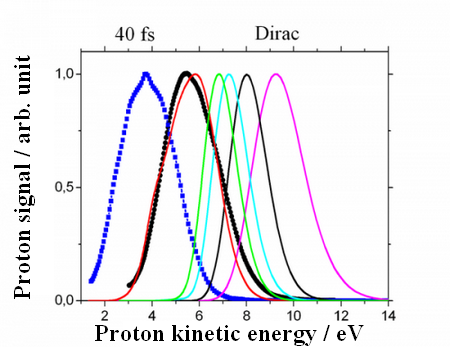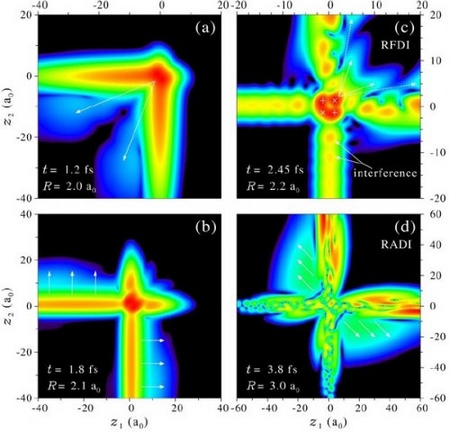Home > Research Teams > Dynamics and Interactions: Radiation, Atoms and Molecules (DIRAM) > Intense laser controlled molecular processes: Electronic and nuclear dynamics > Coulomb explosion of using intense sub-10fs laser pulses
Coulomb explosion of using intense sub-10fs laser pulses
One of the group’s research topic is about molecules on intense laser field. This topic can be divided in at least two themes : the study of molecular processes in intense laser fields applied to resonance and control (see Intense laser controlled molecular processes) and the study of the molecular dynamics in intense laser fields, to which this work on the Coulomb explosion of H![]() belongs. The goal of this work is indeed the theoretical analysis of the interaction between the H
belongs. The goal of this work is indeed the theoretical analysis of the interaction between the H![]() molecule with an intense sub-10fs laser pulse. THe ejection of the two electron leads to a molecular fragmentation in two protons. We study this so-called "Coulomb Explosion" using a non-perturbative, two-active-electron theoretical model based on the resolution of the time-dependent Schrödinger equation. In this model, the internuclear distance is treated on a quantum level, as are the two electronic coordinates. Using a set of theoretical tools, we analysed the influence of different laser parameters on the nuclear and electronic dynamics [3].
molecule with an intense sub-10fs laser pulse. THe ejection of the two electron leads to a molecular fragmentation in two protons. We study this so-called "Coulomb Explosion" using a non-perturbative, two-active-electron theoretical model based on the resolution of the time-dependent Schrödinger equation. In this model, the internuclear distance is treated on a quantum level, as are the two electronic coordinates. Using a set of theoretical tools, we analysed the influence of different laser parameters on the nuclear and electronic dynamics [3].
Both theoretical results and experimental ones, coming from our ongoing collaboration with Christian Cornaggia at Services des Photons, Atomes et Molécules of CEA-Saclay, underline the translation of proton Kinetic Energy Releases (KER) toward higher kinetic energies as the pulse duration decreases, as shown in Fig. 1. We performed this study using pulse durations ranging from 40fs to 10fs experimentally, and down to 1fs theoretically. We also showed that, for pulse durations shorter than 4fs, the Carrier Envelope Phase, which characterizes the shift between the electic field and its temporal envelope, becomes an essential parameter to take into account.

Fig 1. Normalized proton spectra obtained at 8x10![]() W.cm
W.cm![]() for different pulse durations ranging from "Dirac-0fs" to the right to 40fs to the left.
for different pulse durations ranging from "Dirac-0fs" to the right to 40fs to the left.
Furthermore, the molecular dynamics of H![]() in intense laser field is sensitive to the peak intensity of the pulse. Our experimental and theoretical results show that, as the intensity increases, the KER are centered around a higher energy. In addition, the presence of two double ionization regimes is theoretically demonstrated for a pulse duration of 4fs. The H
in intense laser field is sensitive to the peak intensity of the pulse. Our experimental and theoretical results show that, as the intensity increases, the KER are centered around a higher energy. In addition, the presence of two double ionization regimes is theoretically demonstrated for a pulse duration of 4fs. The H![]() molecule is also sensitive to the temporal shape of the laser pulse. This sensitivity allows for the detection of pre- or post-pulses by measuring the experimental kinetic energy spectra [4].
molecule is also sensitive to the temporal shape of the laser pulse. This sensitivity allows for the detection of pre- or post-pulses by measuring the experimental kinetic energy spectra [4].
We also studied the different basic processes occuring during the Coulomb explosion. Results describe the attosecond electronic dynamics of the rescattering mechanism and the influence of the latter on the nuclear femtosecond dynamics [5]. Theoretical results of Fig. 2 show the different physical phenomena occuring during the interaction between the H![]() molecule with a 1-optical-cycle laser pulse. Part (1) of the figure represents the direct double ionization. Part (2) and (3) show the rescattering induced mechanisms. They are the sequential double ionization and the non sequential double ionization, respectively. FInally, after the end of the laser field, protons are still produced by autoionization (part (4)).
molecule with a 1-optical-cycle laser pulse. Part (1) of the figure represents the direct double ionization. Part (2) and (3) show the rescattering induced mechanisms. They are the sequential double ionization and the non sequential double ionization, respectively. FInally, after the end of the laser field, protons are still produced by autoionization (part (4)).

Fig 2. Electronic probability distributions of H![]() at four differents times and internuclear distances as a function of the two electronic coordinates.
at four differents times and internuclear distances as a function of the two electronic coordinates.
Following this work on the analysis of proton spectra, we focus on the analysis of photoelectron spectra during the laser-matter interaction in order to extract information on the transient molecular characteristics (see Femtosecond Electron Diffraction).
[1] M. Nisoli et coll., Appl. Phys. B 65, 189 (1997)
[2] A. Poppe et coll., Appl. Phys. B 72, 373 (2001)
[3] S. Saugout et coll., Phys. Rev. A 77, 023404 (2008)
[4] S. Saugout et coll., Phys. Rev A 73, 041406 ® (2006)
[5] S. Saugout et coll., Phys. Rev. Lett. 98, 253003 (2007)


